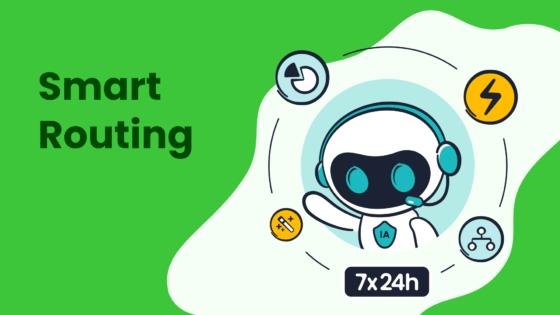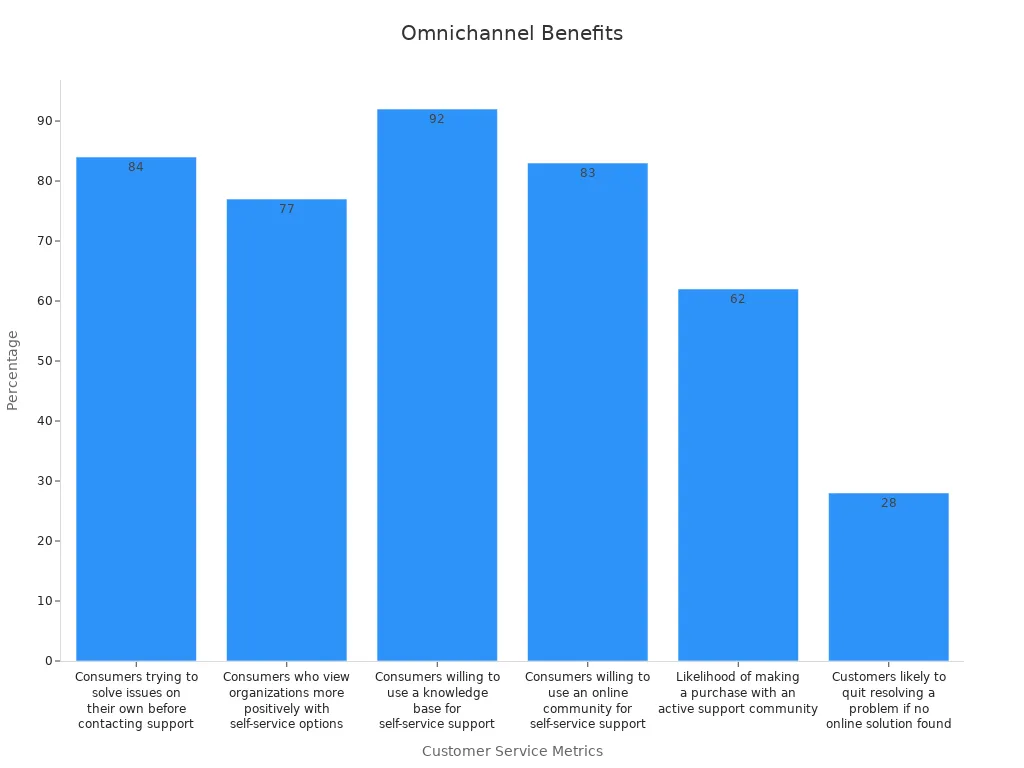How to Create Seamless Omnichannel Customer Service Systems

Omnichannel customer service systems unify communication channels to create consistent and seamless customer experiences. These systems ensure customers can interact with your business smoothly, whether through social media, email, or phone calls. At least three-fourths of consumers expect this level of integration, and they often use six touchpoints during their purchasing journey.
Adopting omnichannel services is crucial in today’s market. Businesses experience 250% higher engagement and purchase rates compared to single-channel campaigns. Customer retention rates also soar by 90%, proving their effectiveness in building loyalty. Tools like Sobot’s omnichannel solution simplify this process by integrating AI-powered technology, enabling businesses to deliver personalized support across all channels.
Understanding Omnichannel Customer Service Systems
What is omnichannel customer service?
Omnichannel customer service ensures that all communication channels work together to provide a seamless and unified customer experience. Whether customers reach out through email, social media, live chat, or phone calls, they receive consistent support without needing to repeat their concerns. This approach focuses on integrating every touchpoint, so you can deliver personalized and efficient service.
For example, imagine a customer starts a conversation on your website's live chat but later calls your support team. With an omnichannel system, the agent on the call can instantly access the chat history, ensuring continuity. This eliminates frustration and builds trust. Research shows that 88% of customers value experiences as much as the products they purchase. By adopting omnichannel services, you meet these expectations and create a lasting impression.
Key characteristics of effective omnichannel services
Effective omnichannel services share several key traits that enhance the customer experience. These systems prioritize integration, real-time data sharing, and flexibility. Cloud-based solutions often power these systems, ensuring scalability and adaptability to your business needs.
Here are some measurable characteristics of successful omnichannel systems:
- Track engagement rates to understand how customers interact with your brand.
- Monitor conversion rates to evaluate the effectiveness of your communication channels.
- Gather customer feedback to identify areas for improvement.
Additionally, businesses with strong omnichannel strategies retain 89% of their customers, compared to just 33% for those with weaker approaches. This retention rate highlights the importance of providing fast, accurate, and personalized responses. Tools like Sobot's omnichannel solution make this possible by consolidating customer data into a unified workspace, enabling your team to deliver exceptional service.
| Statistic | Description |
|---|---|
| 88% | Customers say experiences are as important as products. |
| 33% | Customers find repeating information to agents frustrating. |
| 89% | Retention increases for businesses offering strong omnichannel support. |
Differences between omnichannel and multichannel approaches
While both omnichannel and multichannel marketing involve multiple communication channels, their execution differs significantly. Multichannel marketing uses separate platforms without integration, leading to inconsistent messaging and customer experiences. In contrast, omnichannel marketing connects all channels, creating a unified and seamless journey for your customers.
For instance, multichannel strategies might involve separate teams managing email, social media, and phone support. This lack of coordination often forces customers to repeat their issues. On the other hand, omnichannel strategies integrate these channels, ensuring that every interaction feels connected. This approach not only reduces frustration but also boosts customer loyalty.
Consider these statistics:
- 73% of customers use multiple channels during their shopping journey, but only 7% feel satisfied with the consistency across these channels.
- Companies with effective omnichannel strategies achieve up to 30% higher customer lifetime value due to better data integration and personalization.
- Brands with well-developed omnichannel strategies retain 91% more customers annually.
By implementing an omnichannel strategy, you can bridge the gaps between channels and provide a cohesive experience. Sobot's omnichannel solution exemplifies this by integrating voice, email, and social media into a single platform. This ensures that your customers enjoy smooth interactions, no matter how they choose to connect with you.
The Importance of an Effective Omnichannel Strategy
Enhancing customer satisfaction and loyalty
An effective omnichannel strategy plays a vital role in boosting customer satisfaction and loyalty. When your customers experience seamless transitions across channels, they feel valued and understood. This builds trust and strengthens emotional connections, encouraging them to return to your brand. Consistency across platforms also increases customer retention, as customers are more likely to stay loyal when their interactions are smooth and personalized.
For example, imagine a customer starts a conversation on social media and later follows up via email. With an integrated omnichannel customer service system, your team can access the entire interaction history. This eliminates the need for customers to repeat themselves, creating a delightful experience. Studies show that brands with strong omnichannel strategies retain 89% of their customers, compared to just 33% for those without. By prioritizing seamless customer service experiences, you can foster long-term loyalty and advocacy.
Improving operational efficiency and reducing costs
Implementing an omnichannel customer service strategy not only enhances customer satisfaction but also improves your operational efficiency. Automation and AI-powered tools streamline repetitive tasks, allowing your team to focus on complex customer interactions. Businesses using AI in customer service have reported up to a 30% reduction in operational costs. Additionally, automation reduces response times, leading to faster resolutions and better resource allocation.
For instance, Sobot’s omnichannel solution integrates AI-driven chatbots and voicebots to handle routine inquiries. This reduces the workload on your agents and ensures customers receive quick answers. By 2025, AI is expected to manage 95% of customer interactions, further driving cost savings and operational improvements. These advancements enable you to allocate resources more effectively, ultimately enhancing both productivity and customer satisfaction.
Meeting customer expectations for seamless interactions
Modern customers expect seamless interactions across all channels. Research shows that 73% of shoppers use multiple channels during their journey, yet only 7% feel satisfied with the consistency they experience. An effective omnichannel strategy bridges this gap by unifying communication channels and providing a cohesive customer experience.
Omnichannel customers tend to spend 30% more than single-channel shoppers and are 1.7 times more likely to make repeat purchases. Sobot’s unified workspace consolidates customer data, enabling your team to deliver personalized support across platforms like email, social media, and voice. This ensures every interaction feels connected, meeting customer expectations and driving higher retention rates. By adopting an omnichannel approach, you can exceed customer expectations and position your brand as a leader in customer service.
Steps to Build a Seamless Omnichannel Customer Service System

Mapping customer touchpoints and journeys
Understanding your customer touchpoints is the first step in creating a seamless omnichannel customer service system. Touchpoints are the moments when customers interact with your brand, whether through your website, social media, email, or phone calls. Mapping these interactions helps you identify gaps and opportunities to improve the customer experience.
Start by analyzing customer journey data. Metrics like session activity, bounce rate, open rate, and conversion rate provide valuable insights into how customers engage with your sales channels. For example:
| Metric | Description |
|---|---|
| Session activity | Tracks time spent on specific pages, helping you identify trends or anomalies. |
| Bounce rate | Shows when users leave after viewing one page, reflecting content effectiveness. |
| Open rate | Measures the percentage of emails opened, useful for evaluating email campaigns. |
| Conversion rate | Indicates the percentage of users completing desired actions, such as clicking a call-to-action. |
By understanding these metrics, you can create a detailed map of the customer journey. This map allows you to pinpoint areas where customers face challenges and implement solutions to enhance their experience. For instance, if your bounce rate is high, you might need to improve your website's usability or content relevance. A well-mapped journey ensures that every touchpoint contributes to a cohesive and satisfying customer experience.
Integrating communication channels with Sobot's Omnichannel Solution
Integration is the cornerstone of an effective omnichannel customer service strategy. Without it, your communication channels operate in silos, leading to inconsistent messaging and frustrated customers. Sobot's Omnichannel Solution eliminates these silos by unifying all your customer support channels into a single platform.
This solution supports multiple communication channels, including voice, email, social media, and live chat. It consolidates customer data into a unified workspace, enabling your team to access interaction histories instantly. This integration ensures that customers receive consistent support, regardless of the channel they use. For example, if a customer starts a conversation on social media and follows up via email, your agents can seamlessly continue the interaction without asking the customer to repeat themselves.
Sobot's platform also leverages AI-driven automation to handle repetitive tasks, such as answering FAQs or routing inquiries to the appropriate department. This not only improves response times but also frees up your agents to focus on complex issues. By integrating your communication channels with Sobot's Omnichannel Solution, you can provide a seamless and personalized experience that meets modern customer expectations.

Leveraging technology like Sobot's Voice/Call Center for personalization
Personalization is a key driver of customer satisfaction and loyalty. Sobot's Voice/Call Center offers advanced features that enable you to deliver tailored support to your customers. Nearly 80% of consumers prefer speaking with an agent over the phone, making voice channels a critical component of your customer service strategy.
Sobot's Voice/Call Center includes intelligent IVR (Interactive Voice Response) systems that allow customers to find answers quickly without waiting on hold. It also features automatic call distributors (ACD) that reduce waiting times by routing calls to the most suitable agents. These technologies enhance the customer experience by ensuring fast and accurate resolutions.
Additionally, the platform's unified workspace provides agents with a comprehensive view of customer interactions. This enables them to offer personalized solutions based on the customer's history and preferences. For example, if a customer has previously inquired about a product, the agent can proactively provide updates or recommendations during the call. This level of personalization not only improves customer satisfaction but also strengthens brand loyalty.
By leveraging Sobot's Voice/Call Center, you can transform your customer service operations. The platform's AI-powered voicebots, global number availability, and real-time analytics further enhance your ability to deliver exceptional service. These tools ensure that every interaction feels personal and meaningful, driving long-term customer engagement.
Training teams for cross-channel consistency
Your team plays a critical role in delivering a seamless customer experience. Even the most advanced omnichannel systems can fall short without well-trained agents who understand how to navigate and manage cross-channel interactions effectively. Training ensures your team can provide consistent and high-quality customer service across all platforms.
Start by familiarizing your team with the tools and technologies they will use. For instance, Sobot's unified workspace consolidates customer data from multiple channels, allowing agents to access interaction histories instantly. Training your team to use this feature ensures they can handle inquiries efficiently, regardless of the channel. Role-playing exercises can also help agents practice transitioning between channels, such as moving from a live chat to a phone call while maintaining context.
Focus on developing soft skills like active listening and empathy. These skills are essential for creating personalized interactions that enhance the customer experience. For example, if a customer expresses frustration on social media and later calls your support line, your agent should acknowledge the previous interaction and address the issue with understanding. This approach builds trust and loyalty.
Regular workshops and feedback sessions can further improve your team's performance. Use real-world scenarios to identify gaps in knowledge and provide targeted training. Encourage agents to share their experiences and learn from one another. By fostering a culture of continuous learning, you ensure your team remains adaptable and capable of meeting evolving customer expectations.
Monitoring and optimizing the system continuously
Building an omnichannel customer service system is not a one-time effort. Continuous monitoring and optimization are essential for maintaining its effectiveness and ensuring a superior customer experience. Regularly analyzing performance metrics helps you identify areas for improvement and implement changes that enhance both efficiency and satisfaction.
Key metrics to monitor include response time, resolution rate, and customer satisfaction scores. These metrics provide valuable insights into your system's performance. For example:
| Metric | Description | Purpose in Optimization |
|---|---|---|
| Response Time | The average time taken to respond to customer inquiries. | Helps identify delays and improve efficiency. |
| Resolution Rate | The percentage of issues resolved on the first contact. | Indicates effectiveness of support processes. |
| Customer Satisfaction | Scores reflecting customer feedback on their service experience. | Guides personalization and service adjustments. |
In addition to these metrics, track conversion rates, customer engagement, and customer lifetime value. These indicators reveal how well your system supports your business goals. For instance, a high conversion rate suggests your communication channels are effectively guiding customers through their journey.
Leverage tools like Sobot's analytics features to gain real-time insights into your system's performance. These tools allow you to monitor trends, identify bottlenecks, and make data-driven decisions. For example, if response times are increasing, you might need to adjust staffing levels or refine your workflows.
Regular system audits are also crucial. Test each channel to ensure it integrates seamlessly with others and provides a consistent customer experience. Gather feedback from both customers and agents to identify pain points and opportunities for improvement. By continuously optimizing your system, you can stay ahead of customer expectations and maintain a competitive edge.
Practical Tips for Implementing Omnichannel Customer Service
Using customer data to personalize interactions
Personalization is the cornerstone of a great customer experience. By leveraging customer data, you can tailor your interactions to meet individual needs and preferences. For instance, analyzing purchase history, browsing behavior, and previous customer service interactions allows you to anticipate customer needs and provide relevant solutions.
Consider this: 80% of consumers are more likely to make a purchase when they receive personalized experiences. However, 76% express frustration when interactions lack personalization. This highlights the importance of using data effectively. Tools like Sobot’s unified workspace consolidate customer data from all customer service channels, enabling your team to deliver personalized support seamlessly.
| Statistic | Source |
|---|---|
| 80% of consumers are more likely to make a purchase with personalized experiences | Epsilon |
| 62% of business leaders report improved customer retention due to personalization | Twilio/Segment |
| 71% of customers expect personalized experiences | McKinsey |
By integrating customer data into your omnichannel customer service strategy, you can enhance satisfaction and loyalty while reducing frustration.
Centralizing communication with tools like Sobot's unified workspace
Centralizing communication is essential for creating a seamless customer experience. A unified workspace, like the one offered by Sobot, brings all customer service channels together. This allows your team to access interaction histories, customer profiles, and ongoing conversations in one place.
Centralized communication improves productivity and response times. For example, businesses using unified workspaces report higher task completion rates and better collaboration. With Sobot’s platform, your agents can switch between channels like email, social media, and voice without losing context. This ensures consistent and efficient customer service interactions.
Tip: Use centralized tools to identify high-performing employees and detect productivity issues. This helps you implement targeted training and improve overall team performance.
By centralizing your communication channels, you can streamline operations and provide a cohesive experience for your customers.
Automating repetitive tasks with AI-powered solutions
Automation plays a critical role in reducing repetitive tasks and improving efficiency. AI-powered tools, such as chatbots and voicebots, handle common queries like FAQs and order tracking. This frees up your agents to focus on complex customer service interactions.
For example, Sobot’s AI-driven chatbots provide immediate support for routine inquiries, ensuring faster resolutions. Companies using similar tools have reported significant benefits:
| Company | AI Tool | Task Automated | Benefit |
|---|---|---|---|
| Zendesk | Chatbot | Responses to FAQs | Frees up human agents for complex issues |
| Intercom | Chatbot | Shipping status inquiries | Enhances efficiency in customer support |
By automating repetitive tasks, you can reduce response times, improve customer satisfaction, and optimize your resources. Sobot’s AI-powered solutions ensure your team can focus on delivering exceptional service while maintaining operational efficiency.
Ensuring data security and compliance
Data security and compliance are critical for building trust in your customer service operations. Customers expect their personal information to remain safe, especially when interacting across multiple channels. By implementing robust security measures, you can protect sensitive data and comply with industry regulations.
Key Compliance Standards
Adhering to compliance standards ensures your customer service system meets legal and ethical requirements. Here are some key regulations and their purposes:
| Compliance Regulation | Purpose |
|---|---|
| PCI DSS | Ensures the secure handling of credit card information to prevent fraud and data breaches. |
| GDPR | Governs the handling of personal data and ensures the privacy and security of customer information. |
| HIPAA | Ensures the protection of patient health information in the healthcare industry. |
These standards not only safeguard customer data but also enhance your brand's reputation.
Best Practices for Data Security
To secure your omnichannel customer service system, follow these best practices:
- Map and classify personal data across all channels.
- Implement consent management with clear opt-ins and easy opt-outs.
- Minimize data collection by storing only what is necessary.
- Encrypt sensitive customer data during storage and transfer.
These steps reduce the risk of data breaches and ensure compliance with regulations like GDPR and PCI DSS.
How Sobot Supports Security and Compliance
Sobot's omnichannel solution integrates advanced security features to protect customer data. The platform encrypts sensitive information during storage and transfer, ensuring compliance with global standards. For example, businesses using Sobot can manage customer interactions across channels while maintaining data integrity. This approach not only enhances security but also streamlines operations, allowing you to focus on delivering exceptional customer service.
Tip: Regularly audit your system to identify vulnerabilities and ensure compliance with evolving regulations. This proactive approach keeps your customer service operations secure and trustworthy.
By prioritizing data security and compliance, you can create a safe environment for your customers and foster long-term loyalty.
Tools and Technologies to Support Omnichannel Services

Role of CRM platforms in omnichannel customer service
CRM platforms play a vital role in creating seamless omnichannel customer service systems. These tools centralize customer data, enabling your team to access interaction histories, preferences, and feedback in real time. This ensures every interaction feels personalized and consistent, regardless of the channel.
For example, businesses using CRM platforms can provide faster responses and tailored solutions. A study shows that 84% of customers value the experience a company provides as much as its products. Additionally, 94% of U.S. consumers are more likely to make repeat purchases after a positive experience. With CRM tools, you can meet these expectations by delivering exceptional customer service.
| Statistic | Insight |
|---|---|
| 45.9% of businesses | Rank customer experience as a top priority over the next five years. |
| 53% of top-performing salespeople | Are confident in their CRM data, compared to 32% of non-top performers. |
Sobot’s omnichannel solution integrates seamlessly with CRM platforms, allowing you to unify customer interactions across email, social media, and voice channels. This integration enhances your ability to deliver personalized and efficient customer service.
Benefits of AI-powered chatbots and voicebots
AI-powered chatbots and voicebots revolutionize customer service by automating routine tasks and providing 24/7 support. These tools handle FAQs, order tracking, and appointment scheduling, freeing up your agents to focus on complex issues. They also ensure faster response times, which improves customer satisfaction.
For instance, AI adoption in customer service leads to a 35% cost reduction. Support agents using AI handle 13.8% more inquiries per hour, saving 45% of the time spent on calls. Sobot’s AI-driven chatbots and voicebots enhance accessibility by supporting multiple languages and offering consistent service quality.
| Benefit | Description |
|---|---|
| 24/7 Availability | Ensures help is always available. |
| Faster Response Times | Reduces wait times and improves satisfaction. |
| Cost Efficiency | Minimizes reliance on human agents. |
| Enhanced Accessibility | Simplifies interactions for diverse users. |
| Consistency in Service | Standardizes service quality across all interactions. |
By deploying AI-powered tools, you can optimize your customer service operations and deliver exceptional experiences.
Analytics tools for tracking and improving performance
Analytics tools are essential for monitoring the effectiveness of your omnichannel strategy. These tools provide insights into customer behavior, engagement, and satisfaction, helping you identify areas for improvement. Metrics like Net Promoter Score (NPS), Customer Satisfaction Score (CSS), and Cross-Channel Conversion Rate reveal how well your system supports customer needs.
| Metric | Description |
|---|---|
| Engagement Score | Measures customer interaction levels. |
| Loyalty Score | Reflects the number of loyal customers. |
| Net Promoter Score (NPS) | Evaluates satisfaction and loyalty. |
| Customer Satisfaction Score (CSS) | Assesses satisfaction through feedback and surveys. |
| Cross-Channel Conversion Rate | Tracks purchases after engaging with multiple channels. |
Sobot’s analytics features allow you to track these metrics in real time. For example, you can monitor response times and resolution rates to ensure your customer service system operates efficiently. By leveraging analytics tools, you can continuously optimize your strategy and exceed customer expectations.
How Sobot's Voice/Call Center enhances omnichannel strategies
Sobot's Voice/Call Center plays a crucial role in strengthening your omnichannel customer service strategy. It ensures seamless communication across channels while improving efficiency and customer satisfaction. By integrating advanced features like intelligent IVR, smart call routing, and AI-powered voicebots, this solution transforms how you manage customer interactions.
One of the standout benefits of Sobot's Voice/Call Center is its ability to reduce waiting times by 35%. This improvement ensures your customers receive faster responses, enhancing their overall experience. Additionally, the platform supports global number availability, allowing you to connect with customers worldwide without any barriers. These features make it easier to provide consistent and reliable customer service, no matter where your customers are located.
The platform also drives strategic effectiveness by enabling better omnichannel integration. For instance, it consolidates customer data into a unified workspace, giving your agents instant access to interaction histories. This allows them to provide personalized support, whether the customer reaches out via phone, email, or social media. The result is a cohesive experience that builds trust and loyalty.
Here’s a quick look at how Sobot's Voice/Call Center delivers measurable results:
| Statistic | Value |
|---|---|
| Percentage of business from upgrades | 70% |
| Reduction in waiting times | 35% |
| Benefit to clients | Improved omnichannel integration |
Sobot's Voice/Call Center also empowers your team with real-time analytics. These insights help you monitor performance, identify bottlenecks, and optimize workflows. For example, if call resolution rates drop, you can quickly pinpoint the issue and implement changes. This proactive approach ensures your customer service operations remain efficient and effective.
By leveraging Sobot's Voice/Call Center, you can elevate your customer service to new heights. Its advanced features and seamless integration capabilities make it an essential tool for any business aiming to deliver exceptional omnichannel experiences.
Implementing an omnichannel customer service strategy transforms how you engage with customers. It enhances satisfaction, loyalty, and operational efficiency. With tools like Sobot's Omnichannel Solution and Voice/Call Center, you can unify communication channels, automate repetitive tasks, and deliver personalized support. These solutions empower your team to provide seamless experiences across platforms.
Consider this: 84% of consumers try to solve issues independently before contacting support, and 77% view businesses more positively when self-service options exist. Sobot's AI-driven tools, like chatbots and knowledge bases, cater to these preferences, ensuring faster resolutions and higher satisfaction.
| Statistic | Value |
|---|---|
| Consumers trying to solve issues on their own before contacting support | 84% |
| Consumers who view organizations more positively with self-service options | 77% |
| Consumers willing to use a knowledge base for self-service support | 92% |
| Consumers willing to use an online community for self-service support | 83% |
| Likelihood of making a purchase with an active support community | 62% |
| Customers likely to quit resolving a problem if no online solution found | 28% |

Take the first step by mapping your customer touchpoints. Explore Sobot's solutions to create a seamless, customer-centric system that meets modern expectations.
FAQ
What is the difference between omnichannel and multichannel customer service?
Omnichannel customer service integrates all communication channels into one seamless system. Multichannel systems, on the other hand, operate channels separately, often leading to inconsistent experiences. For example, Sobot’s Omnichannel Solution ensures customers receive consistent support across email, social media, and voice, while multichannel systems lack this integration.
How does Sobot’s Voice/Call Center improve customer satisfaction?
Sobot’s Voice/Call Center reduces waiting times by 35% with features like intelligent IVR and smart call routing. It also provides agents with a unified workspace, enabling personalized support. These tools ensure faster resolutions and better experiences, which directly enhance customer satisfaction and loyalty.
Why is personalization important in omnichannel customer service?
Personalization builds trust and loyalty. Customers feel valued when their preferences and history are acknowledged. For instance, Sobot’s unified workspace consolidates customer data, allowing agents to tailor interactions. Studies show 80% of consumers prefer businesses offering personalized experiences, making it a key driver of customer satisfaction.
How can AI-powered tools enhance omnichannel customer service?
AI-powered tools, like Sobot’s chatbots and voicebots, automate repetitive tasks such as FAQs and order tracking. This reduces response times and allows agents to focus on complex issues. Businesses using AI report up to a 30% reduction in operational costs and improved customer satisfaction rates.
Is Sobot’s Omnichannel Solution secure?
Yes, Sobot’s Omnichannel Solution ensures data security with encrypted storage and transfer. It complies with global standards like GDPR and PCI DSS. This protects sensitive customer information, builds trust, and ensures your business meets regulatory requirements.
See Also
A Comprehensive Approach to Omnichannel Contact Center Solutions
Essential Insights on Omnichannel Call Center Software
Excelling at Live Chat for Retail Businesses
Perfecting Live Chat Strategies for Customer Assistance
Top 10 Recommendations for Social Media Customer Service Tools
